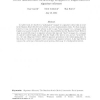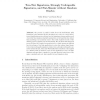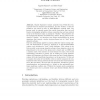21 search results - page 1 / 5 » On the Random-Oracle Methodology as Applied to Length-Restri... |
TCC
2004
Springer
13 years 10 months ago
2004
Springer
In earlier work, we described a “pathological” example of a signature scheme that is secure in the Random Oracle Model, but for which no secure implementation exists. For that...
CORR
2000
Springer
13 years 4 months ago
2000
Springer
We take a critical look at the relationship between the security of cryptographic schemes in the Random Oracle Model, and the security of the schemes that result from implementing...
EUROCRYPT
2012
Springer
11 years 7 months ago
2012
Springer
We provide an alternative method for constructing lattice-based digital signatures which does not use the “hash-and-sign” methodology of Gentry, Peikert, and Vaikuntanathan (ST...
PKC
2007
Springer
13 years 10 months ago
2007
Springer
We provide a positive result about the Fiat-Shamir (FS) transform in the standard model, showing how to use it to convert threemove identification protocols into two-tier signatur...
EUROCRYPT
2003
Springer
13 years 9 months ago
2003
Springer
Abstract. Digital Signatures emerge naturally from Public-Key Encryption based on trapdoor permutations, and the “duality” of the two primitives was noted as early as Diffie-He...



